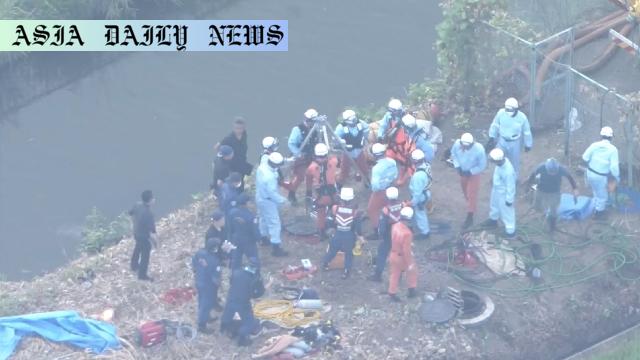Manhole Accident: 4 workers in Saitama rescued but unconscious after falling into a 10-meter-deep sewage inspection site.
Key Point 1: Four workers fell into a manhole while inspecting a sewage pipeline in Gyoda City, Saitama.
Key Point 2: The accident occurred during an emergency inspection ordered after a previous road cave-in in Yashio City.
Key Point 3: All four workers were eventually rescued, but they remain unconscious.

An Unexpected Incident in Saitama
The serene city of Gyoda, located in Saitama Prefecture north of Tokyo, witnessed an intense rescue operation on Saturday morning after a tragic incident. Four workers fell into a manhole while conducting an emergency inspection of a sewage pipe. The task was ordered by the central government in response to a road cave-in occurring earlier this year in Yashio City, highlighting potential vulnerabilities in the region’s infrastructure system. A manhole, typically out of sight and mind, became the focal point of urgency and human endurance as rescue teams acted swiftly to save the trapped workers.
The workers were inspecting a manhole that measured a mere 60 centimeters in diameter and dropped to an alarming depth of over 10 meters. An eyewitness raised the alarm by contacting the fire department to report the workers’ disappearance while they were performing their evaluation. Details reveal that the fall was likely initiated when one worker accidentally plunged into the manhole. The remaining three attempted to rescue their colleague but unfortunately suffered the same fate, resulting in all four becoming trapped more than 10 meters below ground.
Immediate Rescue Efforts
Emergency teams arrived promptly at the scene, understanding the challenging rescue operation that awaited them. Given the restricted dimensions of the manhole and its significant depth, the rescue demanded precision, appropriate equipment, and acute attention to safety measures. After extensive efforts, all four workers were successfully extracted from the manhole. However, the outcome remained disheartening, as all the rescued individuals were reported unconscious at the time of retrieval. They were immediately rushed to nearby medical facilities, and their current condition reflects the severity of the incident.
Authorities are continuing to investigate the circumstances surrounding the accident. It appears that safety protocols in such emergency inspections might require further strengthening to prevent future occurrences of similar tragedies. An initial inspection indicates that the rush in responding to government directives might have unintentionally compromised critical precautions, exposing the workers to unforeseen hazards. This incident has reinvigorated the discourse around worker safety and the importance of on-site risk mitigation measures.
The Context Behind the Emergency Inspection
The investigation into the incident has also raised questions about the context of the emergency inspection itself. The task was initiated as part of a broader inspection mandate from the central government, following a massive road cave-in in Yashio City in January. The cave-in had earlier highlighted the deteriorating state of municipal infrastructure in parts of Saitama Prefecture. Consequently, the central government ordered inspections of sewage lines to ensure safety and preempt additional infrastructure failures.
While these inspections are undoubtedly critical for public safety and preparedness, the tragic incident in Gyoda City emphasizes a pressing need for improved execution strategies. There is a delicate balance between speed and precision in carrying out such operations. Failures in coordination or planning could result in accidents, such as the one in Gyoda, where workers’ lives were put in jeopardy. Moving forward, frameworks must be designed to allow for thorough risk assessment and equipment checks before initiating inspections of potentially hazardous sites.
Ultimately, this incident is a somber reminder of the hazards that frontline workers brave daily and highlights a collective responsibility among authorities, companies, and communities to prioritize occupational safety as a matter of utmost significance.



Commentary
A Sobering Reminder of Workplace Safety
The tragic incident in Gyoda City, Saitama Prefecture, once again underscores the critical importance of prioritizing workplace safety, especially in high-risk environments. The precarious circumstances that led to four workers falling into a manhole demand a careful examination of existing safety measures and protocols. While the idea of emergency inspections is laudable and stems from the need to prevent larger-scale disasters, it is clear that poor execution can lead to adverse outcomes. This begs the question: how can authorities and companies better collaborate to ensure such tragedies do not recur?
The Role of Preparedness and Risk Assessment
One area that warrants immediate attention is risk assessment. It seems that in the rush to inspect sewage lines following the earlier Yashio City road cave-in, some crucial safety checks might have been overlooked. Efforts should always be made to avoid creating additional risks in the name of addressing current hazards. Proper training, safety gear, and alternative inspection strategies, such as the use of robotics or drones in hard-to-reach areas, should be considered. This would not only protect human lives but also allow for more efficient and accurate inspection results.
Honoring Frontline Workers
Finally, the bravery and dedication of frontline workers cannot be overlooked when discussing such incidents. These men and women often risk their well-being to perform tasks that maintain public safety and infrastructure integrity. It is the shared responsibility of governments, companies, and society to ensure that their work is carried out in the safest conditions possible. The event in Gyoda serves as a sobering reminder of why these precautions are so essential: no inspection, however urgent, should come at the expense of lives.